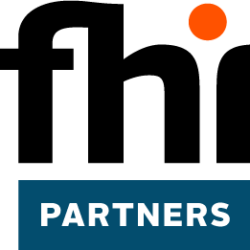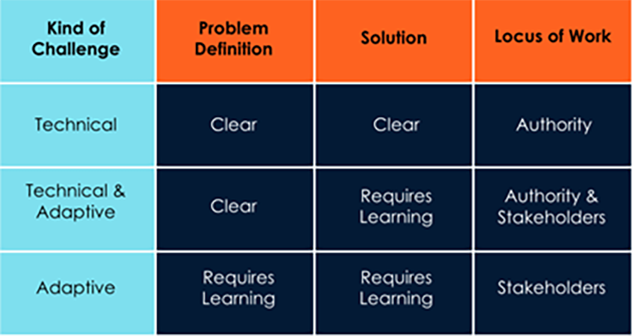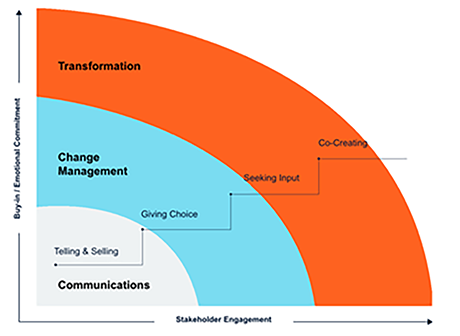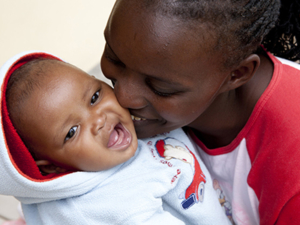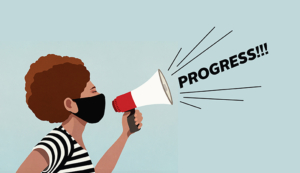
To view part two of this two-part series, visit here
Written by
Richard Crespin, CEO, CollaborateUp
Ricardo Michel, Managing Director, FHI Partners
“Progress is impossible without change, and those who cannot change their minds cannot change anything.” — George Bernard Shaw
Complex societal issues — such as systemic racism, the urban/rural divide and unequal economic growth — have long histories and will be around for years to come. Yet, that should not create apathy or hopelessness. Solving complex problems requires new ways of thinking about ideas that have challenged us for generations. It also involves hard work and time to slog through the three Cs: collaboration, consensus and consultation. Collaboration requires changing our mindset from opposition-based thinking to problem-first thinking. By restating “right versus right” issues to “and” instead of “or,” we can create good for the unit and good for the whole, good for the short term and good for the long term, truth and loyalty, and justice and mercy to seek a consensus that accomplishes both ends to the maximum extent possible.
Forging political consensus will mean breaking down problems in a way that creates a vision for, not against. It also requires discussion and consultation with people often very different from us, with ideas different from ours. If you are looking for easy, quick answers or if you want to be right and prove others wrong, then this two-part blueprint for progress may not be for you. If, however, you are looking to understand the nature of systemic challenges and find lasting solutions built on durable compromise, read further. As a society, we face problems without easy answers, and solutions will require compromise with people whose points of view we may find deeply distasteful. That is the tough part. But there is good news: There are proven ways of navigating these kinds of problems and crafting effective solutions.
The murder of George Floyd at the hands of a Minneapolis police officer sparked waves of international soul-searching on the treatment of racial and ethnic minorities by police, especially in the United States. It also kicked off mostly peaceful but, at times, violent and destructive protests resulting in further instances of violence and brutality at the hands of police officers and counter-protestors. This cycle of violence on both sides divided communities and resulted in an oversimplification of those who are deemed anti-racist and those who support law and order. This polarization was further exacerbated by the global COVID-19 pandemic, which added to an already polarized and tense environment within the United States, where normally banal public health topics like mask-wearing became politicized by dividing communities into pro-science or pro-liberty camps.
In both cases, extremists paint themselves in the best possible light and the other side in the worst. In an era dominated by media attention, the loudest, wildest voices seem to get the most airtime. They focus on the extreme actions of opposing parties, ignoring the substantive issues. As practitioners of social innovation and community collaboration, we expressly and profoundly reject either end of these extremes. Racism in all its forms must be condemned, as must the willful ignorance of science, anarchy, violations of due process and extra-judicial killing. We must move past name-calling and seek political solutions, and we know that this requires compromise as well as collaboration.
We do not presume to know the ideal solution for these perplexing, stubborn issues in the headlines. The scholars, activists, leaders and diverse communities long in the fight know far more about these issues than we do. What we can offer is a process backed by a set of tools and methods for defining complex challenges, bringing parties together to collectively address tough issues that require collective action and creating and nurturing effective partnerships to drive lasting change.
In this two-part blueprint series, CollaborateUp and FHI Partners share core concepts, long used in our work, that leaders on the frontlines of these movements can adapt and use. FHI Partners’ agile, client-centered approach to social impact through collective action, in tandem with CollaborateUp’s lean startup approach to multisector collaboration, provides tools and methods you can adapt for yourself. Using our processes, community leaders can see entrenched issues from a new perspective, invite relevant stakeholders to have a seat at the table and provide a roadmap for forging innovative partnerships needed to create new collaborative capacity between sectors.
We will start with four core how-to concepts: developing problem-first thinking, applying adaptive leadership, engaging stakeholders and having tough conversations. We will follow these with building blocks to help you add more tools to your community leadership toolkit. This first piece focuses on the first core concept.
“Right versus right” issues and problem-first thinking
Most systemic problems are “right versus right” issues. As argued by Dr. Rushworth Kidder in his seminal book How Good People Make Tough Choices, most ethical dilemmas arise when two good things, or multiple bad things, collide and create a situation where, in certain aspects, each side is “right” to argue for the correctness of their perspective. These can be categorized into debates, as below:
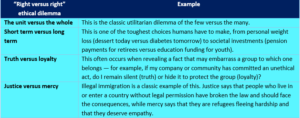
These debates are easy to spot within the stubborn problems we see in the news. Disagreement on the Black Lives Matter movement and police reform often invokes the balance between addressing historic racial injustice and ensuring that law and order remain in place — a “justice versus mercy” debate. Discord over participation in international organizations or systems (such as the World Health Organization, United Nations or NATO) highlights the tension between participating in a global system and pursuing country-first strategies: the good of the many versus the good of the few. How do you resolve these tensions? Short answer: very carefully.
It takes:
- Recognizing that you face an adaptive challenge
- Changing your mindset from solving a “right versus wrong” problem to a “right versus right” challenge
- Engaging stakeholders and helping them to understand and fall in love with the problem
Most people oversimplify the problem, then quickly jump to an oversimplified solution and keep advocating for it, ceasing to listen to the other side. “Defund the police” and “law and order” are classic examples. Both oversimplify the issues, use inflammatory language and shut down discussion with people who disagree, labeling them as racists, anarchists or other pejoratives. Assigning these kinds of labels is particularly damaging because it goes beyond criticizing someone’s behavior (which they can theoretically change) to impugning someone’s character (which they cannot).
Instead, a more disciplined approach would seek to:
- Focus on the problem, placing it at the center of the discussion.
- State the problem, not the solution, in multifactorial terms by using “and” instead of “or.”
- Invite discussion using phrases like “Why … ?”, “How might we … ?”, or “What if we tried …”[1]
For instance, we could say, “How might we eliminate systemic racism and police brutality and keep all people within our communities safe within the rule of law?”
By pursuing a collective strategy that respects complexity and does not shy away from it, we can drive toward systemic, meaningful change. First, we may need to change our own normative thinking and how we view the problem to effectively engage with others in the system. Second, as leaders and proponents of systemic change, we must adopt more deliberate and disciplined approaches to ensure that passion-filled protests become sustained, institutionalized progress. In our next post, we will delve further into the concept of adaptive leadership, a mindset for effectively managing and tackling complex challenges. We will also explore how to engage stakeholders and have tough conversations to bring about successful resolution.
Further information and reading
This two-part blueprint series is part of an ongoing partnership between CollaborateUp and FHI Partners. For more on this and other topics, please contact us at info@collaborateup.com and FHIPartners@fhi360.org and follow us on Twitter at @CollaborateUp and @FHIPartners.
[1] This concept is drawn in part from A More Beautiful Question.

